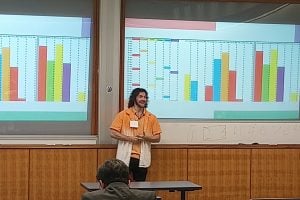
Diran Jimenez, junior systems engineering major in the Department of Civil and Systems Engineering (CaSE) was recognized with the Best Paper Award by the Hopkins Undergraduate Society for Applied Mathematics (HUSAM) at its annual MATRX forum, an event that celebrates undergraduate research. Jimenez’s work centers on Union Craft Brewing, a growing brewery grappling with scheduling challenges for beer production.
“As Union Craft has grown, it’s gotten more and more difficult for production to keep up with demand,” said Jimenez. “The goal was to create a program which automated this process while satisfying all their requirements.”
Developed in collaboration with Melissa Tilashalski, lecturer and director of the undergraduate systems engineering program, Jimenez’s project models the brewery’s operations using a Mixed Integer Linear Programming method, or MILP, to determine the ideal brewing schedule, given constraints like consumer demand, fermentation timelines, number of fermentation and storage tanks, and the amount of beer able to be packaged per day.
“Systems Engineering is, of course, all about systems. But just thinking ‘system’ is really nebulous, so we break systems down into much simpler, more concrete components,” said Jimenez. “First, what factors are in our control? What are the levers we can pull? These are our decision variables. Then, what prevents us from making certain decisions? Those are our constraints.”
Jimenez emphasized the importance of not just solving the problem, but solving it cleanly. “As engineers we’re usually only concerned with whether our end product works. But for this project, I had to push myself to use really clean and efficient methods,” he said.
In addition to refining Jimenez’s research and systems engineering skills, the data collected from Union Craft will serve as the basis for a case study to teach systems modeling to future students enrolled in the Production Systems Analysis course. Students will work to develop their own systems model to optimize the brewery’s production schedule.
“Learning to model systems can be really challenging,” Jimenez said. “Having good examples is critical for developing these skills. It gives students a chance to see what makes or breaks a system, determining whether certain details are fluff or essential to the process. Good examples help students see through the eyes of a more experienced modeler.”
The determining factor in the Best Paper Award was Jimenez’s focus on using the simplest methods possible, ensuring that they could easily be explained or intuitively understood.
Looking ahead, Jimenez’s future is firmly rooted in systems modeling. “I hope to pursue a PhD in operations research, which is all about this type of work,” he said. “It’s something I’m both good at and find deeply rewarding.”